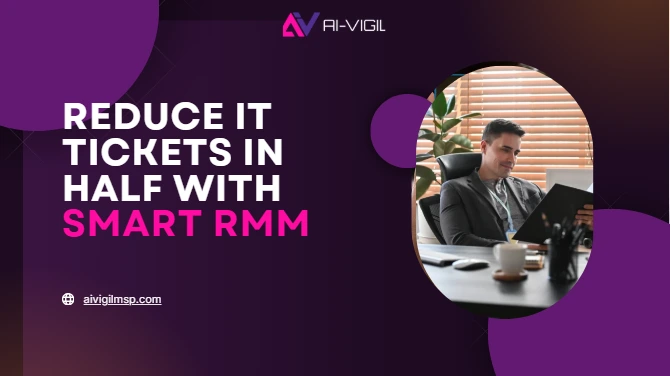IT is no longer an afterthought to many expanding businesses. It belongs to the essential long-term strategy, risk management, and digital transformation. However, the question is whether you need to resort to the usual IT support or you need to enlist a Virtual CIO (vCIO).
Let us analyze it in basic, workable terms, what each of them bring, why this distinction is important and how the correct decision will position your business to an advantage in competition. We’ll also analyze how managed IT services, outsourced IT and all that exists in the new IT world.
What is Virtual CIO
VCIO services do not sell solutions, they sell strategy. A virtual CIO plays the role of an outsourced IT leader which can help align the technological spendings with business objectives. They aid in planning budgets, roadmaps, risk mitigation activities, digital transformations and without a full time executive cost.
Think of a vCIO as your part-time IT executive delivering all the strategic insight that a fulltime CIO would provide just at a fraction of the cost a fulltime CIO would cost, suitable to the small to medium sized businesses. Fantastic IT gives the definition that a vCIO is a person that would create and direct your strategy in tech, and not someone who sets up the printers or opens up passwords.
What Is Conventional IT Support?
Conventional IT support works in a reactive and operative mode. The technology department repairs systems that fail. They maintain networks, update servers, and manage them. However, at the developmental curve, where companies encounter cybersecurity and regulatory as well as digital transformation issues, the reactive approach fails to meet expectations in many cases.
→ Key Difference:
A vCIO knows where the problems lie prior to them and trains your tech to operate in the way your business does, whereas the traditional support reacts to problems in real-time.
The Side of Strategic IT Consulting
This is not a matter of keeping the lights on with fast-changing technology shifts, cloud, remote work, AI, compliance, etc. Support and vCIO services are becoming combined under managed IT services today.
Companies have better clarity and ROI as well as alignment of strategies. Also SMBs that require syncing the tech with their growing business, protection and work-from-home requirements are the best matches with vCIO services.
A vCIO helps with:
- IT budgeting and forecasting
- Vendor management
- Cybersecurity planning
- Disaster recovery strategy
- Regulatory compliance
- Industry-specific tech implementation
For example, in retail, vCIOs can guide omnichannel systems, secure POS integrations, and improve supply chain visibility, exactly the type of tailored guidance that you can learn in our Retailshield.
Why It Matters for Business Growth
Tech moves fast. Businesses with IT-strategy mismatch are the ones that get left behind.
This is why it is good to make a proper choice between vCIO and old-style IT support:
- Security: A vCIO foresees vulnerabilities, and keeps you compliant.
- Cost-Efficiency: It will have better-managed IT budgets and eradicate tech waste.
- Scalability: You do not have to be bound to old infrastructure.
- Smarter Decisions: Tech ceases to be a barrier, and turns into an accelerator.
Whether you are expanding, fighting or merely holding the line, an investment in vCIO services makes it clear and provides the direction you require.
Difference Between CIO Organization and IT department
It is a legitimate one. The IT department is usually a place to administer day-to-day tasks of technology, such as creating email accounts or endpoint administration. A CIO organization on its part establishes the vision: how a technology is aligned with the wider business mission.
A vCIO is similarly a low-cost copy of the latter, with similar benefits of having strategic thinking without the expense of an executive level hire.
When the IT team you have is also busy watching the fire instead of thinking about the future, then you may be relying on an IT department instead of a CIO to organize the way you deal with technology.
What Is The Difference Between a Head of IT and a CIO?
Although both are leadership roles, the Head of IT is more involved with daily running of IT in the organization. Their performance is gauged by uptime, resolution of tickets, and performance of IT metrics.
However, a CIO has the duty of relating technology choices to business vision. Some of their KPIs can be linked to revenue impact, innovation and strategic growth.
With a Virtual CIO, it is CIO on-demand- high level business input without another full-time executive.
Is CIO an IT Job?
Technically, yes, but the CIO position has moved up a lot further than the historic IT. It is now used as a job in business leadership. The modern role of the CIOs (and vCIOs) revolves around offering advice on how to use technology in the generation of revenue, reduction of operational waste, enhancing security, and generating better customer experiences.
Why Virtual CIOs Outperforms in Uncertain Times
The recent years and, in particular, the period of disruption such as the COVID-19 or global supply chain crises showed that the companies that had vCIOs or IT strategy consultants could change faster.
This demonstrates how one can appreciate having in place managed IT services that inculcate long-term vision, and not merely tech support.
Choosing the Right Partner for Strategic IT Consulting
When you are considering a Virtual CIO, look for:
- Well-defined roadmap and planning skills
- Plugging into your current IT Infrastructure
- Practical medical work experience ( in a retail industry, hospital, or factory)
- Variable prices slabs- monthly, quarterly or project wise
And just in case you bid to use those (managed service provider), ask them just in case you can receive or avail of their vCIO services as well. In many cases, it is a scalable vision.
The New IT Superpower Is Strategy
A decision to go with a Virtual CIO or the traditional forms of IT assistance is not either-or decision, it is what the company currently needs. When your technological issues are slowing your improvement or you cannot find the way forward to develop in a safe manner, a virtual CIO can inject vision and planning into the environment.
The process of blending outsourced IT, strategic IT consulting, and some clever budgeting is not just giving you a team to support, but a team that will truly partner with you in innovation.
Think Beyond
Whether it is the choice of our old system of IT or a Virtual CIO, will no longer be a question of technology but a question of how you want your company to develop.
Traditional support will do when you want to have some broken hardware repaired. However, it is more prudent to pursue the vCIO model when your aim is change, financial management, and generating sustainability.
No matter your line of business, retail, healthcare, or some other dynamic area, we have the perfect talent to assist with our one-of-a-kind approach to fine-tuning the industry in the name of driving results.
FAQs:
1. What is the difference between a CIO organization and an IT department?
The aim of CIO organization is to synchronize technology and business strategy. Information technology departments are concerned with technical processes and day to day corrections.
2. What is a virtual CIO?
A virtual CIO is not an employee but a consultant or a service company which provides executive level information technology strategy and planning but not as a full time hire.
3. What is the difference between Head of IT and CIO?
CIO is in charge of the technology process; the head of IT is responsible for operations. One deals with systems and the other makes business using technology.
4. Is CIO an IT position?
Yes, but nowadays it is more of a business position, i.e., facilitating decision-making, not problem-solving.






